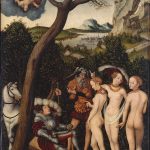Élisabeth Louise Vigée Le Brun, one of the most renowned portrait painters of the 18th century, was born on April 16, 1755, in Paris, France. Raised in an artistic family, her father, Louis Vigée, was a pastel portraitist, providing Élisabeth with an early exposure to the world of art. Recognizing her prodigious talent, her father encouraged her artistic pursuits, and by the age of twelve, she began studying under the tutelage of Jean-Baptiste Greuze and later Joseph Vernet.
Élisabeth’s early artistic endeavors were marked by a remarkable proficiency in portraiture. At the tender age of fifteen, she exhibited her work at the prestigious Salon de Paris, garnering attention for her technical skill and naturalistic approach. Her early success paved the way for an illustrious career that would span decades and leave an indelible mark on the art world.
In 1776, Élisabeth married Jean-Baptiste-Pierre Le Brun, a painter and art dealer, hence adopting the name by which she is most commonly known. Despite societal norms that constrained women in the arts during the 18th century, Élisabeth Vigée Le Brun defied conventions and embarked on a career that would bring her recognition and acclaim.
Her marriage to Le Brun was not without challenges, and the couple faced financial difficulties. However, Élisabeth’s talent and determination soon propelled her to success. Her skillful use of color, attention to detail, and ability to capture the individuality of her sitters set her apart in an era dominated by male artists. She quickly gained favor with the royal court, and her clientele expanded to include the aristocracy and intellectuals of the time.
Élisabeth Vigée Le Brun’s breakthrough came when she painted a portrait of Queen Marie Antoinette in 1778. The portrait, known as “Marie Antoinette and Her Children,” depicted the queen in a more informal and intimate setting, breaking away from the formal traditions of court portraiture. The painting was a resounding success, establishing Élisabeth as the queen’s favorite portraitist and earning her the coveted title of “Portraitist to the Queen.”
The queen’s patronage opened doors for Élisabeth, allowing her to navigate the complex world of the French court. Her ability to capture the grace and charm of Marie Antoinette endeared her to the royal family and positioned her as a central figure in the cultural milieu of late 18th-century France.
The opulence of the French court during this period was reflected in Élisabeth’s portraits, where sumptuous fabrics, intricate details, and a focus on the sitter’s personality became characteristic elements of her style. Her artistry went beyond mere representation; it conveyed the personalities and aspirations of her subjects, creating a visual language that transcended the limitations of portraiture.
Élisabeth Vigée Le Brun’s success extended beyond France. Her international reputation flourished, and she received commissions from European royalty, including the Habsburgs, the Bourbons of Naples, and the Russian Imperial family. Her travels allowed her to experience different cultural landscapes and interact with some of the most influential figures of her time.
In Russia, Élisabeth painted portraits of Catherine the Great and her family, leaving an indelible mark on Russian portraiture. The Empress Catherine appreciated Élisabeth’s talent, and their collaboration resulted in several iconic portraits, including one where Catherine is depicted as Minerva, the goddess of wisdom.
Élisabeth’s time in Russia coincided with the outbreak of the French Revolution in 1789. The political upheaval and the changing dynamics in France presented challenges for the artist. Her close association with the royal court made her a target of suspicion, and she decided to leave France in 1789, embarking on an extended period of self-imposed exile.
During her travels, Élisabeth continued to receive commissions and paint portraits of European nobility. Her stay in Italy allowed her to study and admire the works of the Old Masters, influencing her own artistic style. Despite the challenges posed by political unrest, Élisabeth’s career flourished, and she remained in demand as a portraitist in the courts of Europe.
Élisabeth Vigée Le Brun returned to France in 1802, following the end of the revolutionary turmoil. The changing political landscape allowed her to resume her artistic career in her homeland. However, the art world had evolved, and the Neoclassical style had replaced the Rococo aesthetic that had characterized much of her earlier work.
In the later years of her career, Élisabeth adapted to the changing tastes and continued to paint portraits, although her popularity had waned. Her memoir, published in 1835, provided valuable insights into her life, artistic principles, and the tumultuous period in which she lived. The memoir stands as a testament to Élisabeth’s resilience and her determination to overcome societal constraints imposed on women in the arts.
Élisabeth Vigée Le Brun passed away on March 30, 1842, leaving behind a rich legacy of over six hundred portraits that captured the essence of the 18th-century European aristocracy. Her contributions to the world of portraiture, her defiance of gender norms, and her international success marked her as a trailblazer in the annals of art history. Élisabeth’s ability to transcend the limitations of her time, coupled with her artistic brilliance, ensures her enduring place among the pantheon of great artists who have shaped the course of Western art.




